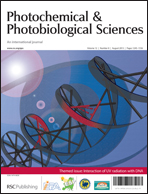DNA damage as a biological sensor for environmental sunlight
Abstract
Solar ultraviolet (UV) radiation is widely known as an environmental genotoxic agent that affects ecosystems and the human population, generating concerns and motivating worldwide scientific efforts to better understand the role of sunlight in the induction of DNA damage, cell death, mutagenesis, and ultimately, carcinogenesis. In this review, general aspects of UV radiation at the Earth's surface are reported, considering measurements by physical and biological sensors that monitor solar UV radiation under different environmental conditions. The formation of DNA photoproducts and other types of DNA damage by different UV wavelengths are compared with the present information on their roles in inducing biological effects. Moreover, the use of DNA-based biological dosimeters is presented as a feasible molecular and cellular tool that is focused on the evaluation of DNA lesions induced by natural sunlight. Clearly, direct environmental measurements demonstrate the biological impact of sunlight in different locations worldwide and reveal how this affects the DNA damage profile at different latitudes. These tools are also valuable for the quantification of photoprotection provided by commercial sunscreens against the induction of DNA damage and cell death, employing DNA repair-deficient cells that are hypersensitive to sunlight. Collectively, the data demonstrate the applicability of DNA-based biosensors as alternative, complementary, and reliable methods for registering variations in the genotoxic impact of solar UV radiation and for determining the level of photoprotection sunscreens provided at the level of DNA damage and cell death.

- This article is part of the themed collection: Interaction of UV radiation with DNA

 Please wait while we load your content...
Please wait while we load your content...